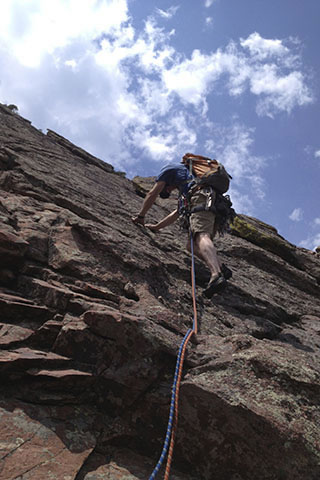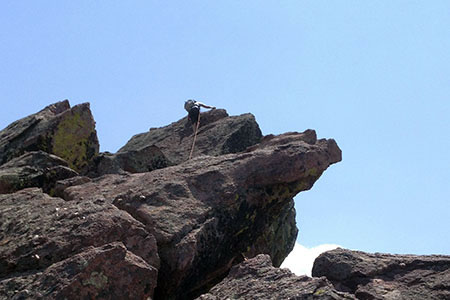| 831 | Fandango! | 2013-07-11 |

Sunday was our last day in Estes Park for a while. We made plans to go to Boulder and climb with our friend, Mark. We chose to climb in the Flatirons.
The Flatirons are big slabs that sit above the City of Boulder. Some of the formations are very large. Mark climbs in the Flatirons regularly, but he does it a bit differently than us. For climbing the slabs, he doesn't normally use a rope. He climbs the easier routes solo.
Being the good natured guy that he is, he climbed with us using a rope.
After a brief discussion of routes to climb, we decided on Fandango on the First Flatiron. The approach was fairly short and the climbing was easy.
Leaving the trailhead, Mark led the way up the network of trails toward the first Flatiron. It wasn't supposed to be hot that day, but soon I was sweating profusely as I tried to keep pace with Mark. Amy was bringing up the rear and was huffing and puffing like she was running a race. Finally, we jumped off the trail and down climbed a bit to the start of the climb.
Unfortunately, another party had just started Fandango. Instead of waiting for them to get ahead, Mark decided the route really started in a different place or, at least, that's what he said.
Quickly the ropes and gear were made ready and our fearless leader, Mark, jumped on the rock and disappeared out of sight. As I fed Mark rope to match his movements I could only imagine that he was prancing up the cliff.
Note: the general routine for climbing, for example a 1,000 foot cliff with a 200 foot rope, is - the first climber leads the way placing removable anchors in the rock along the way. When the lead climber comes to a stopping point (a ledge is nice) he stops and sets anchors that will not fail. Once secure, he links himself to the anchors and then belays the second climber up to his position. When the second climber ascends, he takes out all of the anchors. On reaching the ledge with the first climber, he secures himself to the anchors, and the routine repeats itself.
Amy and I followed Mark and joined him on a ledge. The climbing was not difficult but Mark was not able to set many anchors along the way. It did not seem as if we were on the real start of the route.
Mark began to climb again, but before he led off, he tried to tell us where the route went. He went where he said he'd go, but when he got to the ledge he was hoping to use as a belay, there were no cracks or places to place an anchor. He was out of rope and did not find a ledge where he could set anchors. Rats!
We were in a mini fix, but the answer was apparent - we needed to climb up a ways to give him more rope. Soon, Amy and I were climbing. High above us, Mark was standing on a ledge with the rope wrapped around his back (old style), carefully belaying us, as we carefully climbed toward him. It was definitely time for care for if someone had slipped or fell, we could have all fallen. Yikes.
With a bit more rope, Mark found a belay ledge and the climbing returned to normal. We had a great time and it was a great day on the rocks. Then near the top of the route, we met the party that started Fandango just before we did. We needed to pass them, so Mark turned and asked if we would mind climbing together on the easier section of the route.

Amy on the upper ridge
We didn't mind climbing together, but his asking if we could climb together seemed humorous. After Amy and I had climbed without an anchored belay, climbing together with a running belay seemed safe and secure, but Mark was just being Mark - mindful.
Ha.
When we finished the route, we rappelled down while Mark down-climbed; without a rope of course.
Mark tells a story about a young male that met Mark for the first time. When the youngster found out who Mark was, he exclaimed - I thought you'd be much bigger. Mark is a thin man. But as far as we are concerned he is a pretty big guy!
Thanks for spending the day and climbing with us, Mark.
Happy Fandango Trails